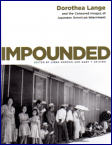About the Editors ORDER -- Item #3439, Price $29.95 Book Description from the Cover FlapsCensored by the U.S. Army, Dorothea Lange's indelible images are an extraordinary photographic record of the Japanese American internment saga.In the devastating aftermath of December 7, 1941, with America reeling from imperial Japan's attack on Pearl Harbor, political leaders and media outlets throughout the country turned their anger inward, branding all Americans of Japanese ancestry as dangerous potential spies and saboteurs. Government, military, and journalistic spokesmen ratcheted up a racist fever against Japanese Americans. Dorothea Lange (1895-1965), the noted documentary photographer, was one of a handful of white people' impelled to speak out. Already a prominent photographer in the employ of the WPA, she was hired by the U.S. War Relocation Authority to photograph the process of the imprisonment of 110,000 Japanese Americans. Once she had secured her role as witness, she devoted herself to the project, working seven days a week throughout the first half of 1942. Impounded tells the historic story of internment from the perspective of the internees. There were no charges or even allegations of disloyalty to the United States against the internees, of whom two-thirds were American citizens. Nevertheless they were detained without trial or even hearings, incarcerated in desolate locations, and housed in rough, cramped barracks surrounded by barbed wire. The first set of images shows what Japanese Americans were losing as a result of the internment; education, productive farms, small businesses, professional careers. The second section documents the roundup of Japanese Americans up and down the West Coast. Lange's simplest images-a pile of cookware, hastily packed luggage, an elderly man waiting in line on a folding stool-evoke the trauma for Japanese Americans of being torn away from what they knew and valued. In the third and fourth sets of photographs we see the full scope and shocking conditions of the imprisonment, both in temporary evacuation centers and in the barracks at Manzanar, the largest and most famous internment camp in California. (Note mistake: cover flap is incorrect. Tule Lake internment camp was the largest.) The army limited Lange's access significantly, prohibiting her from photographing the worst aspects of the incarceration. Being the masterful and unflinching artist that she was, Lange nonetheless produced a powerful visual indictment of the policy. The internment pictures are some of the most moving images of her career: simultaneously beautiful yet devastatingly critical. They were so critical, in fact, that, despite being made at the government's behest, the photographs were confiscated for the duration of the war. An unknown army official even went so far as to write "Impounded" on many prints. Luckily nothing happened to the negatives, which were later quietly retired to the National Archives. Despite Lange's increasing renown as one of the most important documentary photographers of the twentieth century, these photographs are not well known. Few people even know of their existence. A handful of these haunting images have been seen in collections of Lange's work or as illustrations in books about the Japanese internment, but of approximately 760 Lange internment photographs-about one hundred of which are collected here for the first time-the majority have never been previously published. Impounded's editors, both historians, contribute two original essays: Linda Gordon, who is completing a biography of Lange, discusses the process of making the photographs, and Gary Y. Okihiro, one of the nation's leading scholars of Asian American history, discusses the profound effects in the Japanese American community. Here is all the anguish of internment, rendered in photographic form, as told by one of America's most powerful visual storytellers. Impounded is Dorothea Lange's testament to a tragedy that must never be forgotten. Background on Linda Gordon and Gary Y. OkihiroLinda Gordon is a professor of history at New York University. Previously she taught at the University of Wisconsin/Madison and the University of Massachusetts/Boston. A graduate of Swarthmore College with a Ph.D. from Yale University, her scholarship was influenced by the progressive social movements of the 1950s and 1960s. The questions those movements raised led her to examine the historical roots of contemporary social policy debates, particularly as they concern gender and family issues. These books included The Moral Property of Women: The History of Birth Control in the U.S. (a revision of a book originally published in 1976), in 2002; Heroes of Their Own Lives: The History and Politics of Family Violence, in 1988; and Pitied But Not Entitled: Single Mothers and the History of Welfare, in 1994. Experimenting with writing in a storytelling voice, in 1999 Gordon published The Great Arizona Orphan Abduction, a narrative about a 1904 white vigilante action against the Mexican American foster parents of white Children. It was the winner of the Bancroft Prize for best book in American history and the Beveridge Prize for best book on the history of the Americas. She is now completing a biography of Dorothea Lange.Gary Y. Okihiro is professor of international and public affairs and director of the Center for the Study of Ethnicity and Race at Columbia University. He received his Ph.D. in African history at UCLA, and has taught at several universities including Cornell and Princeton. Six of his eight books have won national book awards, and their subject matters range from African to U.S. history. He is perhaps best known for his Margins and Mainstreams: Asians in American History and Culture, and Common Ground: Reimagining American History. He is a recipient of the Lifetime Achievement Award from the American Studies Association, and is a past president of the Association for Asian American Studies.
About | Contact | New | Specials | Browsing | Ordering | Conference | Links | Help Copyright © 2007 by AACP, Inc. Most recent revision February 1, 2007 |

